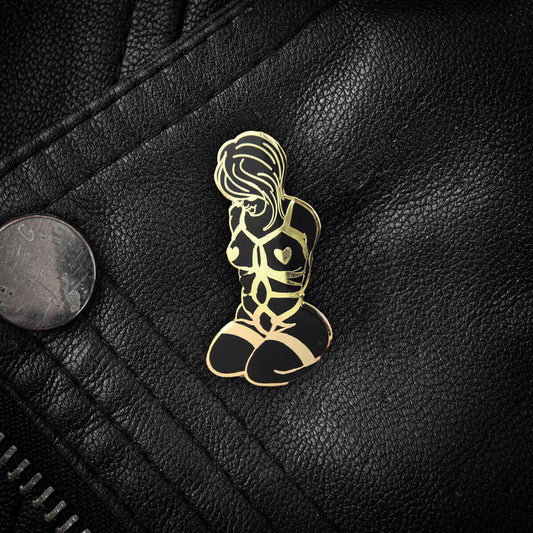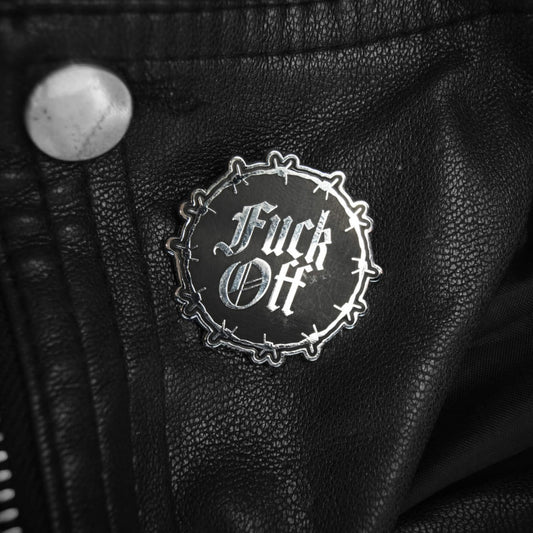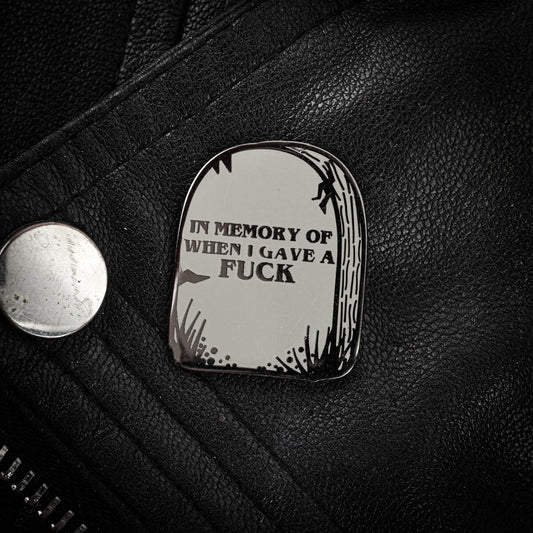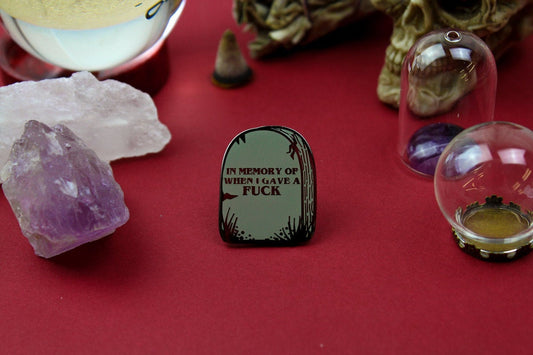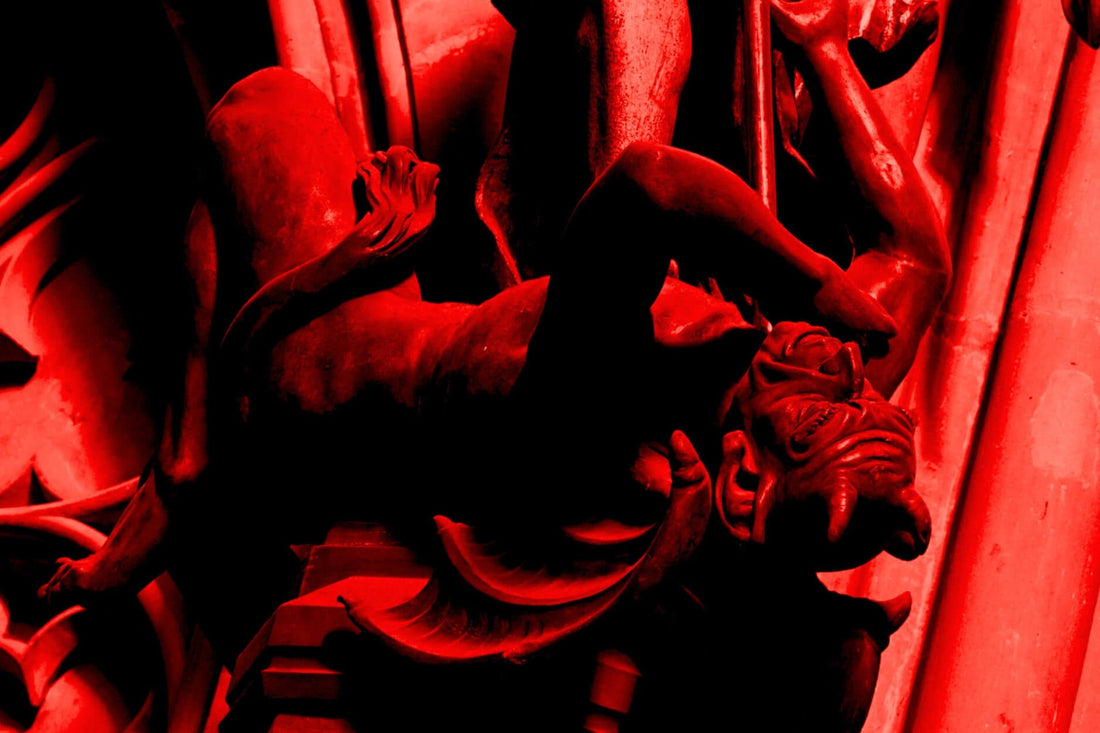
What is Atheistic Satanism?
Share
Atheistic Satanism doesn’t involve belief in the devil, hell, or anything supernatural. In fact, it rejects all of it. There's no worship, no prayers, and no demons in the attic. The word "Satan" in this case is a deliberate choice - used to provoke, to symbolise rebellion, and to question authority.
This philosophy takes its aim at traditional religion, especially Christianity, and flips it inside out. It’s about putting the individual at the centre, not a god. People often assume it’s just shock for the sake of it. But that’s wrong, because there is a structure here. There’s meaning, even if it's laced with sarcasm and theatre.
The point of this article is to lay it out clearly. What atheistic Satanism is, where it came from, and what people actually believe when they call themselves Satanists - without the myths, panic, or nonsense.
Key Points
- Atheistic Satanism is a non-religious philosophy; it rejects all supernatural beliefs, including God and the devil.
- Satan is used as a symbol of defiance, not as a being to worship.
- The Church of Satan focuses on personal strength and elitism; The Satanic Temple pushes activism and secular rights.
- Beliefs centre on self-responsibility, rational thinking, and rejecting religious guilt.
- Shock and satire are tools, not goals; they’re used to challenge authority and provoke thought.
No God, No Devil: The Core Belief
Atheistic Satanists don’t believe in God. They don’t believe in Satan either. That’s the key. There’s no heaven, no hell, and no afterlife. The entire framework is built on atheism and materialism - the idea that this life is all there is, and nothing exists beyond the physical world.
So why use Satan at all? Because he represents defiance. In stories, Satan refuses to bow. That idea - rebellion against blind obedience - is exactly what atheistic Satanism is about. It's not about evil; it's about not being told what to do by anyone claiming moral or divine authority.
The Satan figure becomes a stand-in for personal freedom, self-rule, and scepticism. It's the opposite of worship. Atheistic Satanism says you’re responsible for yourself. No saviour’s coming. No punishment’s waiting. You shape your life, and you live with the outcome.
At its core, it’s a philosophy of self-ownership. Think less devil horns, more middle finger to dogma.
Who Founded Atheistic Satanism?
Atheistic Satanism started with Anton LaVey in the 1960s. He was a former carnival worker, musician, and showman who understood how to grab attention. In 1966, he founded the Church of Satan in San Francisco, calling that year Year One of the Age of Satan. It was part parody, part protest, but also a clear rejection of religious control.
LaVey published The Satanic Bible in 1969. It mixed philosophy, ritual theatre, and blunt commentary on human behaviour. The book became the backbone of modern Satanism. It argued that people should indulge in pleasure, fight hypocrisy, and stop pretending to be pure or holy. The message was simple: stop lying to yourself and stop letting others control you.
LaVey built a persona around this. He wore a black cloak, shaved his head, and played the role of High Priest of Satan. But behind the costume was a strict atheist who didn’t believe in gods, devils, or magic. He used Satan as a symbol - not as a being to worship, but as a mirror to reflect society’s contradictions.
LaVey’s version was elitist, theatrical, and cynical. But it laid the foundation for everything that came after. Without him, atheistic Satanism wouldn’t exist.
The Role of Satan
In atheistic Satanism, Satan is not a real being. He’s a symbol - carefully chosen to annoy the right people and make a point. That point is rebellion. Satan is the outsider, the one who questions rules, breaks with conformity, and refuses to kneel. That’s what makes him useful.
This version of Satan owes more to literature than religion. Think Milton’s Paradise Lost or Shelley’s Prometheus Unbound - not the Bible. He’s not evil; he’s defiant. In Paradise Lost, Satan famously says, “Better to reign in Hell than serve in Heaven.” That line captures the tone perfectly.
To atheistic Satanists, Satan stands for self-ownership, rational thought, and pride in being human. He represents resistance to religious guilt, especially around sex, pleasure, and personal ambition. In a world that often praises obedience and sacrifice, Satan becomes the icon of the opposite: pride, strength, and indulgence without shame.
This use of Satan isn’t random. It’s designed to challenge authority and provoke strong reactions. It forces people to think. If the word “Satan” still causes panic, that’s exactly the point. Atheistic Satanism wants to poke holes in sacred ideas, and Satan is the perfect tool for that job.
Do Atheistic Satanists Worship the Devil?
Nope. They don’t. Not even a little bit. There are no pentagrams drawn in blood, no animal sacrifices, and no late-night demon summoning. That stuff belongs to horror films and panic-stricken church flyers.
Another myth is that Satanists are dangerous or violent. In reality, most are educated, sarcastic, and deeply committed to personal ethics. They don’t believe in harming others without reason, and many are strong supporters of bodily autonomy, freedom of speech, and secular law.
Some people confuse atheistic Satanism with chaos or lawlessness. That’s wrong too. It's not about burning everything down for fun. It's about rejecting forced morality and living by your own rules - as long as those rules don’t hurt innocent people. Most Satanists have a “leave me alone and I’ll leave you alone” attitude. Cross that line, though, and they believe in consequences.
There’s also confusion with theistic Satanists - a completely different group. Theistic Satanists do believe Satan is real, and they worship him in some form. Atheistic Satanists see that as just another religion with a different costume.
The bottom line is atheistic Satanism isn’t about superstition. It’s about rational thinking, personal freedom, and rejecting hypocrisy. The rest is just noise.
Key Organisations
Two main groups dominate atheistic Satanism today: the Church of Satan and The Satanic Temple. They both reject belief in the supernatural, but they operate very differently.
The Church of Satan, founded by Anton LaVey in 1966, is the original organisation. It's private, apolitical, and strongly individualist. Members don’t do activism or public protests. They see Satanism as a personal philosophy, not a community movement. They believe in meritocracy, self-discipline, and standing apart from the herd. If you want rituals, dark aesthetics, and a strict interpretation of LaVey’s original ideas, this is where you land.
On the other hand, The Satanic Temple (TST), founded in 2013, is loud, political, and deliberately provocative. They’ve made headlines for fighting Christian privilege in the U.S., especially in public schools and government spaces. Their tactic is simple: if one religion gets access, then all must. That includes Satanists. And suddenly you’ve got a Satanic monument next to a Ten Commandments statue. Point made.
TST also has its own ethical code - the Seven Tenets - which emphasise compassion, reason, and justice. They’ve organised charity drives, protests, and legal challenges, all wrapped in black robes and irony.
The two groups don’t get along. The Church of Satan calls TST activists “atheist trolls” and insists they’re not real Satanists. TST fires back by accusing the Church of Satan of doing nothing useful. The feud is messy, but it shows how flexible the symbol of Satan has become.
So while both groups reject gods and devils, they take wildly different paths. One stays private and purist. The other is public and combative. Which one matters more depends on what you're looking for: philosophical clarity or real-world disruption.
Photo by Kelly Sikkema on Unsplash
Beliefs and Ethics
Atheistic Satanism isn’t lawless. It just doesn’t rely on commandments from a higher power. Instead, it builds its values around logic, personal responsibility, and consequence. If you mess up, you deal with it. No forgiveness from above. No eternal reward either.
Anton LaVey’s version, laid out in The Satanic Bible, is blunt. He promotes indulgence over abstinence, vengeance over forgiveness, and pride over humility. You don’t turn the other cheek - you hit back if someone wrongs you. It's eye-for-an-eye thinking, but with a cold, rational edge.
Then there’s The Satanic Temple’s approach. Their Seven Tenets read almost like a progressive ethics code. They emphasise bodily autonomy, compassion, scientific understanding, and justice. The first one? “One should strive to act with compassion and empathy toward all creatures.” Not quite what people expect from a group called Satanic.
What unites these views is the rejection of guilt-based morality. Atheistic Satanists believe humans are animals with instincts and desires. Denying that, they argue, creates repression and hypocrisy. Instead of pretending to be perfect, they say: be honest about who you are.
Morality isn’t thrown out - it’s redefined. Instead of "sin," the focus is on harm. If your actions don’t hurt others and are grounded in reason, then you’ve done nothing wrong. If they do hurt someone, you take responsibility. There's no devil to blame, no god to ask for a clean slate.
It’s harsh, sometimes selfish, but also consistent. Atheistic Satanism sees ethics as a personal code, not a divine order. You choose it, you follow it, and you live with the results.
Is It Just for Shock Value?
That’s the common accusation: it’s all theatre, all edge, no substance. And yes, atheistic Satanism uses shock. The name alone guarantees a reaction. But that doesn’t mean it’s hollow. The provocation has a point.
Shock is used to disrupt. Say you want to protest religious displays on public land. Most people ignore it. But if a group calling itself Satanic demands equal treatment, suddenly everyone’s paying attention. The message gets through precisely because it’s uncomfortable.
Anton LaVey understood this from the start. He deliberately built Satanism as a mirror held up to society’s hypocrisy. He dressed in robes, held strange rituals, and used occult symbols to mock religious traditions that, in his eyes, were already full of contradictions. He wasn’t summoning spirits - he was making people squirm, on purpose.
The Satanic Temple does the same thing, but with lawsuits and billboards instead of black masses. Their campaigns are designed to rattle people out of blind obedience. Want to put a Ten Commandments statue outside a courthouse? Fine, but make room for Baphomet too. Suddenly, that religious display doesn’t feel so neutral.
Of course, there’s always going to be people who get into it for the aesthetic. The black clothes, the candles, the imagery - it attracts a certain kind of drama. But the serious adherents aren’t just role-playing. They’re using a loaded symbol to fight for real-world principles: free speech, secularism, and autonomy.
Shock is the delivery system. The message underneath is deliberate.
Why Do People Choose It?
People don’t become atheistic Satanists because they want to be evil. They’re not trying to summon dark forces or curse their enemies. They choose it because it gives them a framework to reject religious control without losing a sense of identity or purpose.
For some, it starts with frustration. Maybe they grew up in strict religious homes. Maybe they saw hypocrisy in church leaders. Atheistic Satanism offers a way out - a philosophy that doesn’t just abandon religion, but actively flips it on its head.
Others are pulled in by the symbolism. Satan represents the outcast, the rebel, the one who refuses to kneel. That appeals to people who’ve felt excluded, judged, or forced to conform. It’s not about pretending to be powerful. It’s about owning your choices, especially the ones that don’t fit neatly into polite society.
Some are drawn to the bluntness. There's no sugar-coating, no pretending everything happens for a reason, no need to believe in miracles or divine plans. Atheistic Satanism says: you are responsible for your life. If that sounds cold, it’s also freeing. No guilt for being human. No invisible judge watching you.
Then there’s the political angle. Groups like The Satanic Temple attract people who want to challenge religious privilege, especially in public spaces. For them, Satanism is a tool to defend secularism and fight back against religious overreach - with irony, sarcasm, and legal muscle.
And yes, some just like the look! The art, the jewellery, the black clothes, the outsider vibe - it’s part of the appeal. But most who stick with it aren’t posing. They’re people who’ve found a philosophy that matches how they think: unapologetic, grounded in reason, and deeply suspicious of anything claiming to be sacred.
